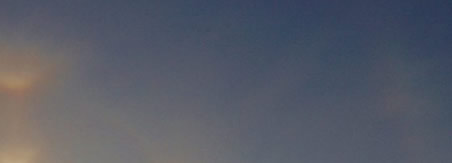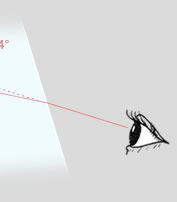
OPOD
What's New
Rays & Shadows
Water Droplets
Rainbows
Ice Halos
Contents
Crystals
Frequent Halos
Infrequent Halos
Why infrequent?
46° Halo
Supra/infralateral
Parry Arcs
Lowitz Arcs
Moilanen Arc
Kern Arc
120° Parhelia
44° Parhelia
Subhorizon Arcs
Pyramidal
Multiple Displays
Other Worlds
Observing Halos
HaloSim
High Atmosphere
Links & Resources
Search - Index
123456789012345678
| Moilanen Arc |
 |
|
| The "V" shaped arc above the sun and half way to the upper tangent arc/22° halo is the rare Moilanen arc. Imaged by Steinar Midtskogen (webcam) during the Oslo display of December 16, 2007. ©Steinar Midtskogen, shown with permission. |
The Moilanen arc is named after its discoverer, halo expert Jarmo Moilanen of Finland. The rare “V” shaped arc, varying in position with solar altitude, has been observed during natural halo displays but is seen more often in the diamond dust formed downwind of ski-slope snow machines. The Oslo display (above) was seen and photographed over a wide area but the Moilanen arc only shows in Steinar Midtskogen's images. A ski-slope with operating machines was 1.5 km away and while the main halo display was natural, the M-arc could have originated from machine crystals**. The arc is easily simulated using prisms
of apex angle 34° aligned
as shown and taking all rotational positions about a vertical
axis. Identifying the ice crystals that actually produce it is
quite another matter. An ice interfacial angle of 34° is crystallographically
improbable as would be the orientation of an isolated prism. Furthermore,
no other associated halos, for example a lower M-arc or ones from
other interfacial angles present, have been observed
which further limits the crystal possibilities. Despite the hard
work of Finnish observers in photographing diamond dust displays
and sampling crystals from them, the crystal source of the arc
remains unknown. It is one of the unexplained halos. |
** |
Snow machines eject small seed nuclei into the air on which halo forming ice crystals subsequently grow from condensation of atmospheric moisture. The growth occurs over hundreds of metres to several kilometres downwind. The snow machines that make the best halos use enzymes as a crystal growth nuclei. The crystals have the same structure, forms and habits as naturally occurring ones. However, for reasons not yet understood (type of nucleate, atmospheric conditions), they can be near optically perfect and generate rare halos. |



